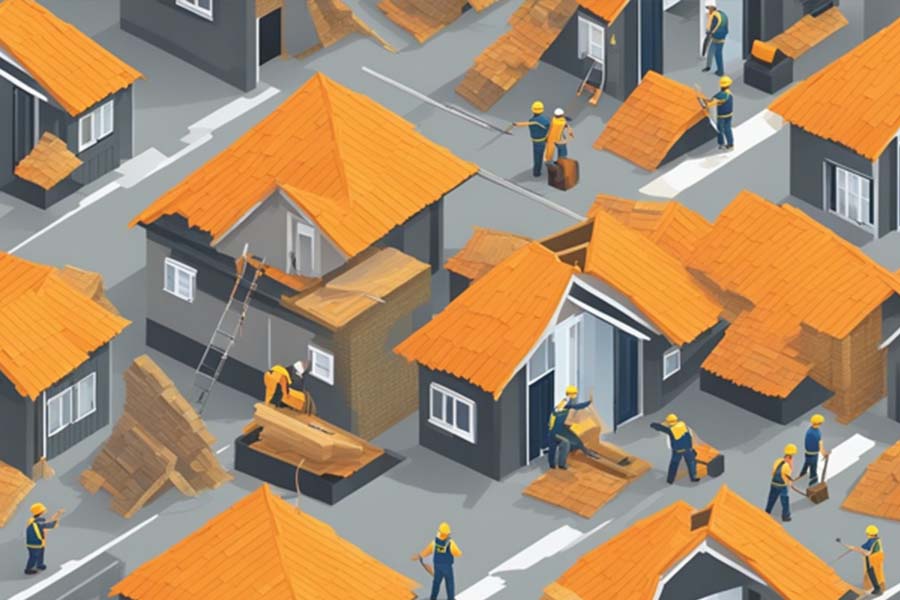Timely roof repairs can save homeowners a significant amount of money in the long run. While some may think that waiting until a roof needs to be replaced is the most cost-effective option, this is not always the case. In fact, delaying necessary repairs can lead to more extensive damage and ultimately result in a higher cost for replacement.
Roof repairs are often necessary due to damage caused by weather, wear and tear, or other factors. Ignoring these issues can lead to leaks, mold growth, and other problems that can be expensive to fix. By addressing these issues promptly, homeowners can avoid more serious damage and save money in the long run. Additionally, regular maintenance and repairs can extend the life of a roof, delaying the need for replacement and further reducing costs.
In this article, we will explore why timely roof repairs are more cost-effective than replacement. We will examine the benefits of regular maintenance and repairs, and provide tips for homeowners on how to identify and address common roofing issues. By taking a proactive approach to roof maintenance, homeowners can avoid costly repairs and replacement, and ensure the longevity of their roof.
Understanding Roof Lifespan
Roofs are exposed to various weather conditions, including rain, snow, hail, wind, and extreme temperatures. These elements can take a toll on the roof, causing it to deteriorate over time. Understanding the lifespan of a roof is essential in determining whether to repair or replace it.
The lifespan of a roof largely depends on the type of material used in its construction. For instance, asphalt shingle roofs typically last between 15 to 30 years, while metal roofs can last up to 50 years or more. Other factors that affect the lifespan of a roof include the quality of installation, the level of maintenance, and the severity of weather conditions in the area.
Regular maintenance of a roof is crucial in extending its lifespan. This includes cleaning gutters, removing debris, and repairing any damages promptly. Neglecting maintenance can lead to premature roof failure, which can be costly to repair.
It is important to note that even with proper maintenance, a roof will eventually reach the end of its lifespan. When this happens, it is recommended to replace the roof rather than continually repairing it. This is because repairing an old roof can become costly and may not be as effective in preventing future leaks and damages.
In conclusion, understanding the lifespan of a roof is crucial in making informed decisions about roof repairs and replacements. Proper maintenance can extend the lifespan of a roof, but eventually, it will need to be replaced to ensure the safety and protection of the building and its occupants.
Identifying Common Roof Issues
Leaks and Water Damage
One of the most common issues with roofs is water damage caused by leaks. Water can seep into the roof through small cracks or gaps and cause significant damage over time. If left unaddressed, water damage can lead to mold growth, rotting wood, and structural damage. Signs of water damage include stains on the ceiling or walls, peeling paint, and musty odors.
Damaged Shingles
Shingles are the outermost layer of protection on a roof and can become damaged due to weather, age, or poor installation. Damaged shingles can lead to leaks, as well as other issues such as mold growth and pest infestations. Signs of damaged shingles include missing or cracked shingles, curling or buckling shingles, and granule loss.
Structural Problems
Structural problems with a roof can be caused by a variety of factors, including poor construction, age, and weather damage. These issues can lead to sagging or uneven roofs, which can cause water to pool and lead to leaks and other damage. Signs of structural problems include sagging or uneven rooflines, cracks in the foundation or walls, and visible damage to the roof structure.
It is important to identify and address these common roof issues as soon as possible to prevent further damage and costly repairs. Regular inspections and maintenance can help catch these issues early on and save homeowners money in the long run.
Benefits of Timely Repairs
Cost Savings
Timely roof repairs are more cost-effective than replacement as they help in preventing major issues that can lead to extensive repair costs. Repairing a small leak or crack in the roof can save a homeowner from having to replace the entire roof, which can be a significant expense. Additionally, repairing the roof in a timely manner can prevent water damage to the home’s interior, which can be costly to repair.
Extended Roof Life
Regular roof repairs can help extend the life of a roof. By addressing small issues as they arise, homeowners can avoid major damage to the roof and prolong its lifespan. This can save a homeowner money in the long run, as they won’t have to replace their roof as frequently.
Prevention of Major Issues
Timely roof repairs can prevent major issues from occurring. For example, repairing a small leak can prevent water damage to the home’s interior, which can lead to mold growth and other issues. Additionally, repairing a damaged roof can prevent it from collapsing, which can be dangerous and costly to repair.
Overall, the benefits of timely roof repairs are clear. By addressing small issues as they arise, homeowners can save money, extend the life of their roof, and prevent major issues from occurring.
Comparing Repair and Replacement Costs
When it comes to roof maintenance, homeowners often face the dilemma of whether to repair or replace their roofs. While both options have their advantages, weighing the costs is crucial to make an informed decision. Here’s a comparison of repair and replacement costs to help homeowners make the right choice.
Repair Costs
Repairing a roof involves fixing specific areas of damage, such as leaks, cracks, or missing shingles. The cost of repairs depends on the extent of the damage and the type of materials used. On average, homeowners can expect to pay between $300 and $1,100 for minor repairs, while major repairs can cost up to $3,000 or more.
Replacement Costs
Replacing a roof involves tearing off the existing roof and installing a new one. The cost of replacement depends on the size of the roof, the type of materials used, and the complexity of the installation. On average, homeowners can expect to pay between $5,000 and $10,000 for a standard asphalt shingle roof replacement. However, more complex installations, such as metal or tile roofs, can cost up to $25,000 or more.
Cost-Effectiveness
While replacing a roof may seem like a more permanent solution, it’s not always the most cost-effective. In most cases, repairing a roof is a more affordable option, especially if the damage is minor. Additionally, timely repairs can extend the lifespan of a roof and prevent more extensive damage, saving homeowners thousands of dollars in replacement costs.
In conclusion, comparing repair and replacement costs is crucial in making an informed decision about roof maintenance. While replacing a roof may seem like a more permanent solution, repairing a roof is often more cost-effective, especially if the damage is minor. Homeowners should weigh their options carefully and consult with a professional to determine the best course of action for their specific needs.
When to Repair vs. When to Replace
When it comes to roof maintenance, it is important to know when to repair and when to replace. Repairing a roof is often a more cost-effective solution than replacing it entirely, but there are certain situations where replacement is necessary.
Repairing a Roof
Roof repairs are a great option when the damage is minor and localized. For example, if there is a small leak or a few missing shingles, a repair can usually fix the problem. Additionally, repairs are often a good choice when the roof is relatively new and in good condition overall.
Replacing a Roof
Replacing a roof is necessary when the damage is extensive or the roof is old and has reached the end of its lifespan. If the roof is leaking in multiple places or has significant damage, replacement may be the only option. Similarly, if the roof is nearing the end of its expected lifespan, it may be more cost-effective to replace it rather than continually repairing it.
It is important to note that replacing a roof can be a significant expense, but it is often a worthwhile investment in the long run. A new roof can increase the value of a property and provide peace of mind knowing that the home is protected from the elements.
In summary, knowing when to repair vs. when to replace a roof is crucial for maintaining the integrity of a home. Repairs are a good option for minor damage or relatively new roofs, while replacement is necessary for extensive damage or aging roofs.
How Regular Maintenance Reduces Long-Term Costs
Regular maintenance of a roof is essential to ensure its longevity and prevent costly repairs or replacements. By scheduling regular inspections and maintenance, homeowners can identify and address minor issues before they become major problems.
One of the main benefits of regular maintenance is that it can help to extend the life of a roof. By identifying and repairing small leaks, cracks, or other issues early on, homeowners can prevent these issues from becoming larger and more costly to fix. Regular maintenance can also help to prevent damage from severe weather events, such as heavy rain, wind, or snow.
Another benefit of regular maintenance is that it can help to reduce long-term costs. By addressing minor issues early on, homeowners can prevent the need for more costly repairs or replacements down the road. Regular maintenance can also help to improve the energy efficiency of a home, which can lead to lower utility bills over time.
To ensure that their roof is in good condition, homeowners should schedule regular inspections and maintenance with a qualified roofing professional. During these inspections, the roofing professional will check for signs of damage or wear and tear, and make any necessary repairs or recommendations for further maintenance.
In summary, regular maintenance is an essential part of ensuring the longevity and cost-effectiveness of a roof. By addressing minor issues early on, homeowners can prevent costly repairs or replacements down the road, and improve the energy efficiency of their home.
Professional Inspection and Assessment
When it comes to roof repairs, it’s important to have a professional inspection and assessment done by a qualified roofing contractor. A professional inspection can identify any potential issues with your roof, allowing for timely repairs that can prevent more costly damage down the line.
During a professional inspection, the contractor will examine the roof for any signs of damage, including cracks, leaks, and missing or damaged shingles. They will also check the flashing and gutters to ensure they are functioning properly.
The assessment will provide you with a clear understanding of the condition of your roof and any necessary repairs that need to be made. This information can help you make an informed decision about whether to repair or replace your roof.
By having a professional inspection and assessment done, you can ensure that your roof is in good condition and that any necessary repairs are made in a timely manner. This can help you save money in the long run by preventing more costly repairs or even a full roof replacement.
Choosing Quality Materials for Repairs
When it comes to repairing a roof, choosing the right materials is crucial. Using low-quality materials may seem like a cost-effective solution in the short term, but it can lead to more expenses in the long run. Therefore, it is essential to choose high-quality materials that can ensure the longevity and durability of your roof.
One of the most important factors to consider when choosing materials for roof repairs is the type of roofing system. Different roofing systems require different materials, and it is essential to choose the ones that are compatible with your roof. For instance, if you have a shingle roof, you need to choose shingles that match the existing ones in terms of color, style, and material.
Another important factor to consider is the quality of the materials. High-quality materials can withstand extreme weather conditions, resist moisture, and prevent damage from UV rays. Additionally, they can ensure the structural integrity of your roof and prevent leaks and other issues.
It is also important to consider the warranty offered by the manufacturer. A good warranty can provide you with peace of mind and protect you from unexpected expenses. Therefore, it is recommended to choose materials that come with a warranty of at least 20 years.
In summary, choosing quality materials for roof repairs is crucial for ensuring the longevity and durability of your roof. By considering factors such as the type of roofing system, the quality of the materials, and the warranty offered by the manufacturer, you can make an informed decision and ensure that your roof remains in good condition for years to come.
DIY Repairs vs. Professional Services
When it comes to repairing a roof, homeowners may be tempted to tackle the job themselves to save money. While DIY repairs can be cost-effective, they can also be dangerous and lead to further damage if not done properly.
Professional roofing services have the experience and knowledge to identify and fix problems quickly and efficiently. They also have access to specialized tools and materials that may not be available to the average homeowner.
Additionally, professional services often come with warranties and guarantees, giving homeowners peace of mind that the job was done correctly. On the other hand, DIY repairs do not offer any guarantees and may end up costing more in the long run if the repair is not done correctly.
It’s important to weigh the pros and cons of DIY repairs versus professional services before making a decision. While DIY repairs may seem like a cost-effective option, they can be risky and potentially lead to more damage. Hiring a professional may cost more upfront, but it can save homeowners money in the long run by ensuring the repair is done correctly and preventing further damage.
The Impact of Weather on Roof Health
The weather can have a significant impact on the health of a roof. Different types of weather conditions can cause damage to the roof, which can lead to leaks and other problems.
One of the most common weather-related issues that roofs face is water damage. When it rains, water can seep into small cracks and crevices in the roof, causing damage over time. This can lead to leaks, which can cause further damage to the roof and the interior of the building.
In addition to water damage, strong winds can also cause damage to the roof. High winds can lift shingles and other roofing materials, which can cause them to become loose or even blow off completely. This can leave the roof vulnerable to further damage from water and other weather conditions.
Extreme temperatures can also have an impact on a roof’s health. In hot temperatures, the roof can expand and contract, which can cause damage to the roof’s structure over time. In cold temperatures, ice and snow can accumulate on the roof, which can cause damage to the roof’s structure and lead to leaks.
Regular maintenance and timely repairs can help prevent damage caused by weather conditions. By identifying and repairing small issues before they become larger problems, building owners can save money in the long run by avoiding costly roof replacements.
Warranty Considerations for Repairs
When considering roof repairs, it is important to take into account any warranties that may be in place. Many roofing materials come with manufacturer warranties that cover defects and premature failure. However, these warranties may be voided if repairs are not performed in a timely and proper manner.
It is important to note that warranties typically only cover defects in the materials themselves and not damage caused by external factors such as severe weather or improper installation. Therefore, it is crucial to have a professional assess the damage and determine if it is covered under warranty before proceeding with repairs.
In addition, some roofing contractors may offer their own warranties for repairs. These warranties may cover the workmanship and installation of the repairs, but it is important to carefully review the terms and conditions to ensure that they provide adequate coverage.
Overall, taking warranty considerations into account when making decisions about roof repairs can help ensure that the repairs are performed in a manner that is both cost-effective and provides long-term protection for the roof.
Insurance and Roof Repairs
When it comes to roof repairs, insurance can be a significant factor in the cost-effectiveness of the repair. Homeowners with insurance coverage for their roofs can save a considerable amount of money on repairs.
Typically, insurance policies cover roof damage caused by natural disasters, such as hailstorms, strong winds, or heavy rain. It is essential to understand the specifics of your insurance policy to determine what is covered and what is not.
If your roof is damaged, the first step is to contact your insurance company and file a claim. An adjuster will assess the damage and determine the amount of coverage available for the repair. It is essential to have a professional roofer assess the damage as well to ensure that all necessary repairs are included in the claim.
Once the claim is approved, the homeowner can choose a reputable roofing contractor to complete the repairs. It is crucial to select a contractor who is experienced in working with insurance companies and can provide detailed documentation of the repairs for the insurance company.
In conclusion, having insurance coverage for your roof can be a significant cost-saving factor when it comes to repairs. It is essential to understand your policy and work with experienced professionals to ensure that all necessary repairs are covered and completed correctly.





0 Comments